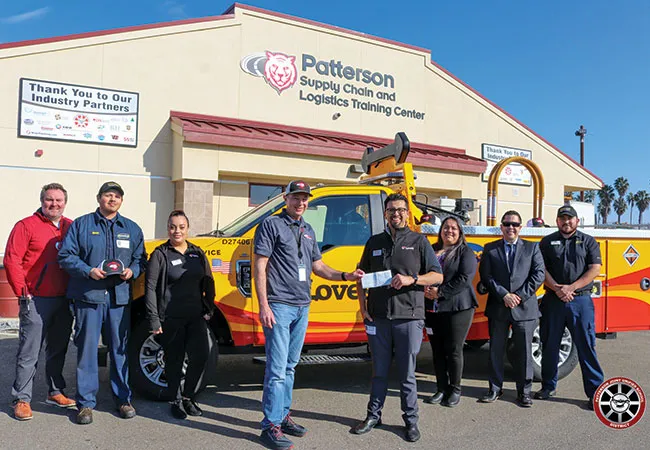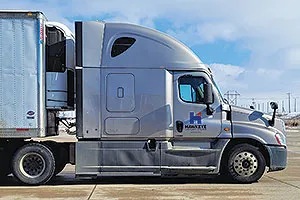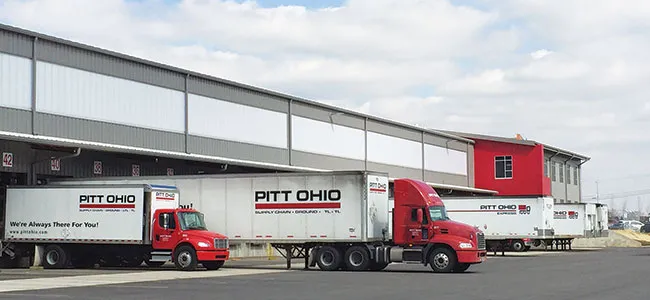CDL Schools, Driver Training Programs Focus on the Right Fit

Officials at Patterson High School in California often look for students who have a passion for a truck driving career. The school's CDL coordinator, Dave Dein (center with hat) says a problem facing the industry is that some people entered it just for money. (Patterson High School)
[Stay on top of transportation news: Get TTNews in your inbox.]
The driver shortage and turnover are top concerns within the trucking industry, and insiders contend commercial driver license schools and training programs play a critical role in attracting new entrants, educating applicants about the lifestyle challenges that come along with being a professional driver, and matching drivers with the right fleet.
“For the well-being of our industry, it is critical that CDL schools work to determine if someone is the right fit for this profession,” said Dave Dein, CDL coordinator at Patterson High School in California. “Part of the issue our industry is facing is that too many people decided to pursue trucking strictly for the money, and that lack of passion is having a negative effect on our image and reputation.”
Jeremy Reymer, founder of DriverReach, a provider of driver recruiting software, said it is in everyone’s best interest to level-set expectations. “It is a great job with good pay, and it is always going to be in demand as long as you’re alive,” he said. “The downside is you’re going to be at the mercy of the type of freight you’re hauling, and options may be limited upfront.”
Celeste Turner, manager of the regional transportation training center for Hawkeye Community College in Iowa, said the school’s staff meets with interested students to discuss their career and lifestyle goals, such as how often they want to be home and if they want to handle freight.
“Driving a commercial vehicle is not for everyone,” Turner said, adding that a wide range of jobs are available to CDL holders. “You don’t have to go longhaul and don’t have to make it your lifelong career. We encourage the student to pursue the career that best fits their lifestyle.”
At Trainco Truck Driving Schools, employees talk to potential students about over-the-road, regional and local jobs, how those pay, and their demands, Vice President Mike Moscinski said.
Trucking Workforce by Age Group

(Graphic: Juan Sorto/Transport Topics; Source: American Transportation Research Institute)
Vetting Programs
One of the challenges for potential CDL students is finding reputable training. Shawn Davis, owner of Tennessee CDL School, said students must be wary of scams or unqualified programs. “You have to make sure the school is approved in the state in which you are actually working,” he said.
The Federal Motor Carrier Safety Administration’s Entry Level Driver Training regulations, which took effect in 2022, set the baseline for training requirements for entry-level drivers. “That has changed the game in trucking,” said Marilyn Surber, head of industry relations at Tenstreet, a software company that connects drivers and carriers. “Now they’re starting to enforce it, and the end result is a safer driver, a safer industry and a better reputation.”
Driving a commercial vehicle is not for everyone. You don’t have to go longhaul and don’t have to make it your lifelong career. We encourage the student to pursue the career that best fits their lifestyle.
Celeste Turner, manager of the regional transportation training center for Hawkeye Community College
Image
Dein said ELDT standards are “a great first step,” but more can be done. “Sadly, there are still ‘CDL mills’ that operate out of financial greed and have no remorse for inadequate training of their students,” he said. “Students need to beware of programs that offer training based on how fast someone can get their license and at the cheapest price.”
Lesley Vincent, field recruiting manager for Melton Truck Lines, said that before hiring students, she looks at the length of CDL training programs and checks to see if the school is part of the Commercial Vehicle Training Association or National Association of Publicly Funded Truck Driving Schools. “We have found that both of those organizations provide exceptional training,” she said, adding that the company hires from community colleges, tech schools and private schools.
When selecting a program, students should ask questions about the curriculum, teaching methods, driving time and the student-to-teacher ratio. Tennessee CDL School, for example, has a 4-1 student ratio.
“That gives them proper time to observe the maneuvers and understand it. We also take them on the road, and they learn the fundamentals — backing, pre-trip, how to connect the truck and trailer together,” Davis said.

Reymer
Students should also ensure they can train on the size and type of vehicle they want to drive and look at the school’s placement rate, which Turner said is more important than the completion rate. “We have a 98% placement rate,” she added.
Reymer suggests students ask schools to share details on the top five carriers they’ve sent graduates to in the past six months. “Recency matters,” he said.
Matching students with their ideal carrier will contribute to their long-term success in the industry. Surber said schools typically get to know what certain carriers are looking for in drivers.
Davis uses technology from Tenstreet to help place students. “The application with Tenstreet allows me to look at their background, work history and other things they have going on to determine which companies will take them,” he said. “We can go through our checklist, match it up and say, ‘Here are one or two good companies that will work for you.’”
Keeping Curriculum Current
Mark Murrell, co-owner of CarriersEdge, said that although the fundamentals of defensive driving haven’t changed, real-world applications have. “Roads are busier, there’s more technology incorporated into the vehicle and new best practices emerge around those things,” he said.
Also, infrastructure is changing. “Highway roundabouts are a relatively new phenomenon across our country. There is a little bit of teaching change that happens with that,” Moscinski said.

Murrell
What’s more, the industry continues to evolve the definition of “successful driver,” Murrell said. “The best-performing companies are looking for drivers who not only deliver freight safely and reliably but also manage the customer experience, coach younger drivers and contribute ideas back to the company to improve operations. That means a greater focus on communication skills, leadership and bigger-picture thinking.”
Davis said it is important for schools to help students prepare for the lifestyle they’ll encounter as a professional driver. “When you choose an over-the-road job, you’re choosing that lifestyle. It is just as much about learning how to adapt mentally,” he said.
However, the basics still matter the most, and simulators are creating new opportunities for students to practice and master skills. “A driver simulator gives you a chance to practice in a way that isn’t scary,” said Lindsey Trent, president and co-founder of the Next Generation in Trucking Association. “It takes the stress out of that training.”

Hawkeye Community College encourages graduates to stay engaged with the school and pull in to show off their trucks. (Hawkeye Community College)
At Hawkeye Community College, students spend extra time in the simulator if they struggle with specific skills, such as backing or shifting.
Simulators also offer built-in remediation so that students can correct faults immediately. “The best thing about using simulators is that I can teach skill sets that I can’t teach in real life,” Dein said.
Those skills could include reacting to a tire blowout, handling mountainous terrain, or driving in snow or rain.
Training From Within
Carriers that hire students have higher retention rates compared with carriers that only hire experienced drivers, and Tenstreet’s Surber said more and more carriers are open to hiring students.
“They’re seeing the value of getting a driver in to show them their way from the beginning,” Surber explained, adding that carriers typically provide additional training. “I can’t think of any carrier hiring students that doesn’t have some type of finishing program that will usually consist of classroom or in-the-field training.”
COMTO's April Rai offers tips to increase workforce diversity and grow profits.. Tune in above or by going to RoadSigns.ttnews.com.
Michael Robinson, vice president of safety and driver development at C.A.T., based in Quebec, said the company hires individuals before they start school and supports them during their program.
Once they finish school, the company provides four months of additional training. Drivers are partnered with trainers who accompany them in the cab and later serve as mentors. Drivers also receive a driver ambassador in the office to provide additional support and check in regularly.
“We concentrate on the basic standards. Learning how to back a truck up, navigate corners and city streets and work with customers is a big deal,” Robinson explained. Drivers also learn how to use the satellite system, deal with officers and manage hours of service. “You’re learning the whole job. That doesn’t happen in school.”

Robinson
When hiring from schools, Tulsa, Okla.-based Melton Truck Lines, which ranks No. 82 on the Transport Topics Top 100 list of the largest for-hire carriers in North America, conducts a pre-hire evaluation to identify any areas where students are struggling and works with them individually, depending on their needs. Then, new hires are partnered with a driver trainer.
“Our trainers do a fantastic job preparing a student for life on the road as well as evaluating their driving skills,” Vincent said.
Pitt Ohio Transportation Group offers CDL training through its advancement program, hiring employees first as dockworkers. “We’d like to move anybody we hire for the dock into a driving position,” said Jeff Mercadante, vice president of safety for Pitt Ohio, which is based in Pittsburgh and ranks No. 60 on the for-hire TT100. “There is always an incentive for them to keep moving up, and it is a great career path for them. They don’t have to pay anything out of their pockets.”

Pitt Ohio offers CDL training through its advancement program. “We’d like to move anybody we hire for the dock into a driving position,” says Jeff Mercadante, vice president of safety. (Pitt Ohio)
Pitt Ohio’s dockworkers can sign up for the advancement program and work with a certified driver trainer. “If they are 21 and over, they can go into a straight truck to get a CDL. If they’re under 21, they can only go into a sprinter van,” Mercadante said, noting that the company only handles interstate freight.
As part of the straight truck training, program participants spend about 400 hours with a driver trainer and complete ELDT training via an industry partner’s web-based training program. After safely driving a straight truck for one year, they can sign up to drive a tractor-trailer and do another 400 hours of training. Mercadante said the staggered program increases safety and boosts retention.

Dannecker
A. Duie Pyle, based in West Chester, Pa., and ranked No. 66 on the for-hire TT100, also transitions dockworkers to professional driving positions. When a box truck driving position opens up, “a hardworking, dependable team player will be given the opportunity to take that spot,” said Pete Dannecker, vice president of risk and integrated resources for the fleet. “If they commit to moving up to driving a tractor-trailer at the end of the year, we’ll train them to drive the box truck and put them to work driving.”
If they decide driving isn’t for them after training on the box truck, A. Duie Pyle will move them back to the docks. Otherwise, they advance to the eight-week Pyle Truck Driving Academy.
“When they have their Class A CDL in hand, we put them behind the wheel, making deliveries with a driver trainer next to them in the passenger seat for about two weeks before they move on to driving solo,” Dannecker said.
Staying Connected
Having and maintaining connections with others in the industry can help students truly understand trucking, and it contributes to job satisfaction, too. “The more they can interact with actual companies while they’re in the program and learning to be a professional driver, the better. Then they can hear from other people what it is really like,” Trent said.
Hawkeye Community College encourages graduates to stay engaged with the school and pull in to show off their trucks. “We want them to come back and talk to our students,” Turner said.
Moscinski said networking happens organically at Trainco, and students stay in touch once they graduate. “Most people that go through the school together as a group are pretty attached. They usually get to know each other’s story,” he said. “They’re cheering each other on, and they generally stay in communication.”
Want more news? Listen to today's daily briefing below or go here for more info:






